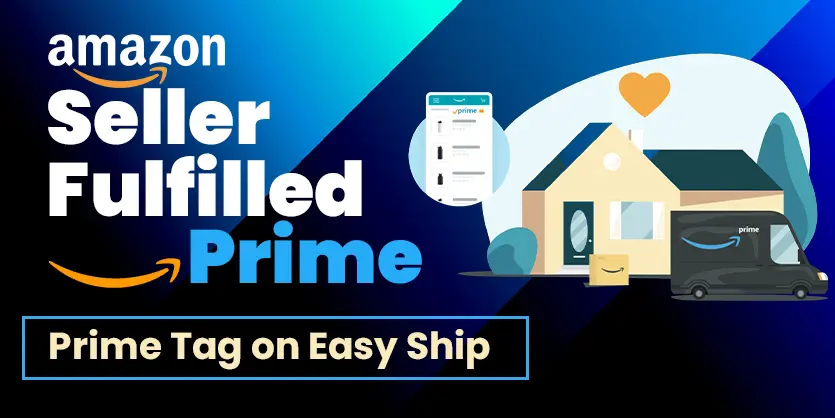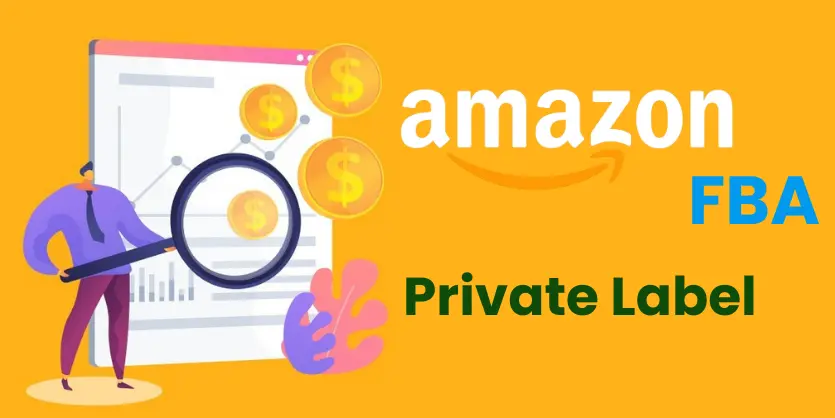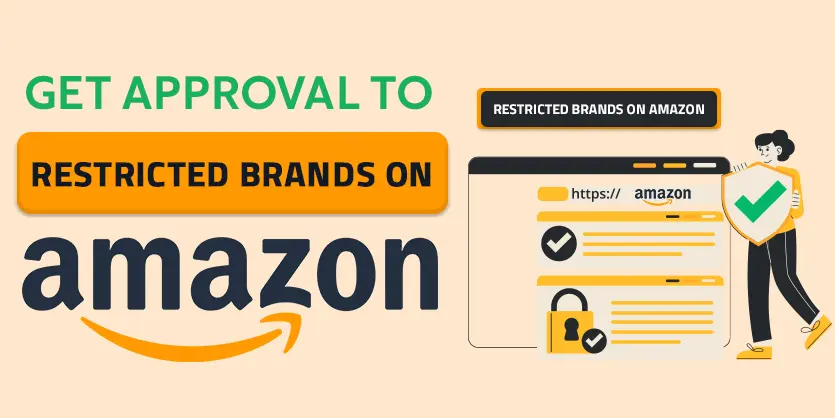Amazon Seller-Fulfilled-Prime is Back again! Now you can sell your products with Prime branding directly from your warehouse. This could be a great opportunity for many sellers to shine on Amazon without even using FBA. You might be wondering, “Is Amazon Seller Fulfilled Prime or SFP right for my business?”. In this article, we will walk you through everything you need to know about SFP so that you can decide whether it’s the right fit for you or not.
A quick view into the article:
- What is Seller Fulfilled Prime (SFP)?
- Why did Amazon Launch SFP?
- Key Differences Between FBA, FBM, and SFP
- Which Products are Best for Seller Fulfilled Prime?
- Amazon SFP Requirements
- Pros & Cons of Seller Fulfilled Prime
- Final Thoughts
What is Seller Fulfilled Prime (SFP)?
Seller Fulfilled Prime (SFP) is a unique Amazon program that allows sellers to proudly showcase the coveted Prime badge on their products while maintaining autonomy over storage, packing, and shipping processes. Unlike Fulfillment by Amazon (FBA), where Amazon oversees every aspect of fulfillment, SFP empowers sellers to streamline their logistics independently. This independence extends from personalized inventory management strategies to efficient packing and shipping workflows, enabling sellers to align with the customer-centric expectations associated with the Prime program. SFP combines the marketing benefits of the Prime badge with the operational flexibility that appeals to sellers with well-established and efficient logistics operations.
Why did Amazon Launch SFP?
In 2015, Amazon introduced Seller Fulfilled Prime (SFP) with the ambitious goal of enabling sellers to independently manage the fulfillment of their products while still providing the seamless, fast, and free delivery synonymous with the Prime program. This move aimed to offer sellers an alternative to Fulfillment by Amazon (FBA) and popular third-party fulfillment services like Deliverr, which could be as costly as FBA for certain products and weren’t always a viable alternative.
However, Amazon recognized that the SFP program fell short of delivering the high-quality experience expected by Prime customers. Consequently, in September 2020, Amazon temporarily halted new seller enrollments for SFP. During this hiatus, Amazon worked diligently to enhance support for sellers and establish clear standards to elevate the SFP program’s performance, ensuring it met the stringent expectations of Prime customers.
Fast forward to 2023, and Amazon is set to reopen enrollment for Seller-Fulfilled Prime in 2023. Notably, the initial announcement included a 2% fee for all Seller Fulfilled Prime orders; however, in response to valuable seller feedback, Amazon has decided to eliminate this fee. This change not only reflects Amazon’s commitment to refining its services based on user input but also positions Seller Fulfilled Prime as an increasingly attractive fulfillment option for businesses. Stay tuned to discover more about the revamped Seller Fulfilled Prime and how your company can leverage this opportunity by signing up in 2023.
Key Differences Between FBA, FBM, and SFP
Understanding the differences between Fulfillment by Amazon (FBA), Fulfillment by Merchant (FBM), and Seller Fulfilled Prime (SFP) is crucial for sellers to choose the right fulfillment method for their business model. The key differences are:
Fulfillment Responsibility: FBA takes full responsibility for the storage, packing, and shipping of products. FBM Sellers are entirely responsible for the storage, packing, and shipping of their products. And SFP strikes a balance, allowing sellers to manage their fulfillment processes independently. Sellers maintain control over their inventory and shipping logistics while enjoying the benefits of the Prime badge.
Prime Badge Eligibility: Products fulfilled through FBA automatically qualify for Prime eligibility, offering customers the fast and free shipping associated with the Prime program. Prime eligibility is not automatic for FBM. SFP provides sellers with the opportunity to display the Prime badge on their products. However, sellers must adhere to stringent performance standards to maintain this eligibility.
Inventory Control: For FBA, sellers relinquish control over inventory management as Amazon oversees the storage and restocking of products in their fulfillment centers. FBM Sellers have complete control over inventory management, allowing them to adjust stock levels, implement pricing strategies, and handle storage as they see fit. SFP Sellers retain control over their inventory, enabling them to manage stock levels independently and make strategic decisions based on their business needs.
Shipping Speed and Costs: FBA offers fast and reliable shipping, but sellers incur fees for storage and fulfillment services. FBM Sellers are responsible for meeting Amazon’s strict shipping standards, ensuring fast and reliable delivery. While offering autonomy, SFP demands efficient logistics to meet Prime customer expectations.
Program Costs: FBA involves fees for storage, order fulfillment, and other services. FBM Sellers have more control over costs, but expenses include storage, packaging materials, and shipping fees determined by their chosen carriers. SFP Originally proposed a 2% fee for all orders, but as of 2023, Amazon has removed this fee based on seller feedback, making SFP more cost-effective.
Which Products are Best for Seller Fulfilled Prime?
Selecting the right products is integral to maximizing the benefits of Seller Fulfilled Prime (SFP), a program that allows sellers to independently manage their fulfillment processes while enjoying Prime benefits. Here are some types of products that align well with the advantages offered by SFP:
- High-value items: A high-value item is an expensive item, such as mobile phones, electronics, expensive jewelry, and many other things. Adding these items allows enrolling in Seller Fulfilled Prime.
- Products with seasonal or unpredictable demand: Classified as seasonal are those products only offered for a brief period, typically during a particular season of the year. They may relate to a holiday, a special event, or a change in the climate. Seasonal products include things like swimwear, winter jackets, and holiday decorations.
- Items with variations: Product variants allow businesses to determine how many variations of an individual product are available. For example, if a product such as a t-shirt is available in six different sizes and five different colors, then there is a total of 30 variations of the same product.
- Slow-moving goods: Slow-moving items are goods or products with a low turnover rate and are stored in the warehouse for a much longer period. Due to the slowness in selling the goods, the slow-moving items are stored or make space for a long.
- Inventory that requires special handling or preparation: Special handling products like glass and glossary items are easily breakable when delivered. So, it needs extra care when packing those items.
Amazon SFP Requirements
SFP is not open to all sellers. Since Amazon wants to shield its Prime reputation, SFP is not made accessible to all sellers. Instead, they have set high-eligibility Seller Fulfilled Prime requirements to sell via SFP.
Requirements for Seller Fulfilled Prime as an enrolled seller:
- Free one-day and two-day delivery for Prime customers
- Free nationwide standard shipping for all customers
- Meet minimum thresholds for one-day and two-day delivery speeds as viewed by Prime customer detail page views
- An on-time delivery rate of at least 93.5%
- A valid tracking rate of at least 99%
- A seller-initiated cancellation rate of less than 0.5%
- Ship and deliver Prime orders on weekends (Saturday, Sunday, or both)
- Offer Free Returns on items weighing under 50 lb
- All post-order customer service inquiries are managed by Amazon
To embark on the Seller Fulfilled Prime (SFP) trial and demonstrate readiness to meet the high standards associated with the Prime program, sellers must meet specific pre-qualification criteria and trial criteria.
Pre-qualification criteria for SFP trial over the past 90 days:
- Have a domestic US address as your default shipping address
- Have an Amazon Professional selling account
- Self-fulfilled at least 100 packages
- Cancellation rate less than 2.5%
- Valid tracking rate greater than 95%
- Late shipment rate less than 4%
Then you can register for the SFP trial period from here.
Criteria to pass the SFP trial:
- Participate for 30 days
- Ship 100 or more packages from Prime trial orders
- An on-time delivery rate of at least 93.5%
- A valid tracking rate of at least 99%
- A seller-initiated cancellation rate of less than 0.5%
- Meet minimum thresholds for one-day and two-day delivery speeds as viewed by Prime customer detail page views
Once you complete the trial period, Amazon will automatically enroll you into SFP and your product listing will then display the Prime badge!
Pros & Cons of Seller Fulfilled Prime
Like any fulfillment method, Seller Fulfilled Prime comes with its own set of advantages and challenges. Here’s a closer look at the pros and cons sellers encounter with Seller Fulfilled Prime.
Pros:
- You have access to Amazon’s 150 million Prime members. 67% of Amazon Prime members said if they had to shop at only one store, it would be Amazon.
- You don’t have to pay FBA fees or storage fees. Because SFP charges are based on weight and dimensions, you might make more money with SFP than with FBA because of how Amazon charges.
- It helps you compete for the Buy Box. Products listed with the Prime badge have increased chances to win the Buy Box over an FBM offer. Even if you were selling your product via FBM, your price would have to be considerably lower than an FBA or SFP offer to get the Buy Box.
- By centralizing your operations, you will gain more control and insight into your Amazon inventory. You’ll avoid lag time between sending inventory into an Amazon FBA warehouse and worrying about running out of stock. Another choice is to store and ship SFP orders through a third-party fulfillment center.
Cons: During the trial period, sellers cannot display the Prime badge, however, SFP orders still need to be processed with a zero-day handling time and delivered within two days with free shipping. If sellers have to start the trial period over, this could incur additional shipping costs. You have to meet Amazon’s strict standards to maintain SFP status. You have to handle returns. Amazon will now charge an extra fee for SFP orders. And You cover the cost of storing and shipping items.
Final Thoughts
In conclusion, Seller Fulfilled Prime is a valuable option for sellers seeking a middle ground between the convenience of FBA and the autonomy of FBM. By understanding the program’s requirements, advantages, and challenges, sellers can make informed decisions about whether SFP aligns with their business goals. As e-commerce continues to evolve, programs like SFP underscore the importance of flexibility and choice in meeting the diverse needs of Amazon sellers and customers alike.
If you have any queries, please let us know through the comment box or email us at info@ecomclips.com. We understand that every situation is different, so we offer a personalized approach to our service.
To know more about Amazon, please check out our other blog. Also, you can check our YouTube videos related to Amazon.
Amazon FBA Inventory Planning | IPI Score and Re-Stock Items to FBA Guide 2023
Amazon SEO: 7 Tips to Optimize Your Listings and Rank High | Boost Your Listings & Increase Sales
Variation Wizard in Amazon | Use Variation Wizard to add a Variation to Existing Listing on Amazon
Amazon Section 3 Suspension | Reinstate Your Account Now with the Perfect Appeal Letter
5 Strategies To Drive External Traffic To Amazon Listings | Maximize Your Sales Potential in 2023



